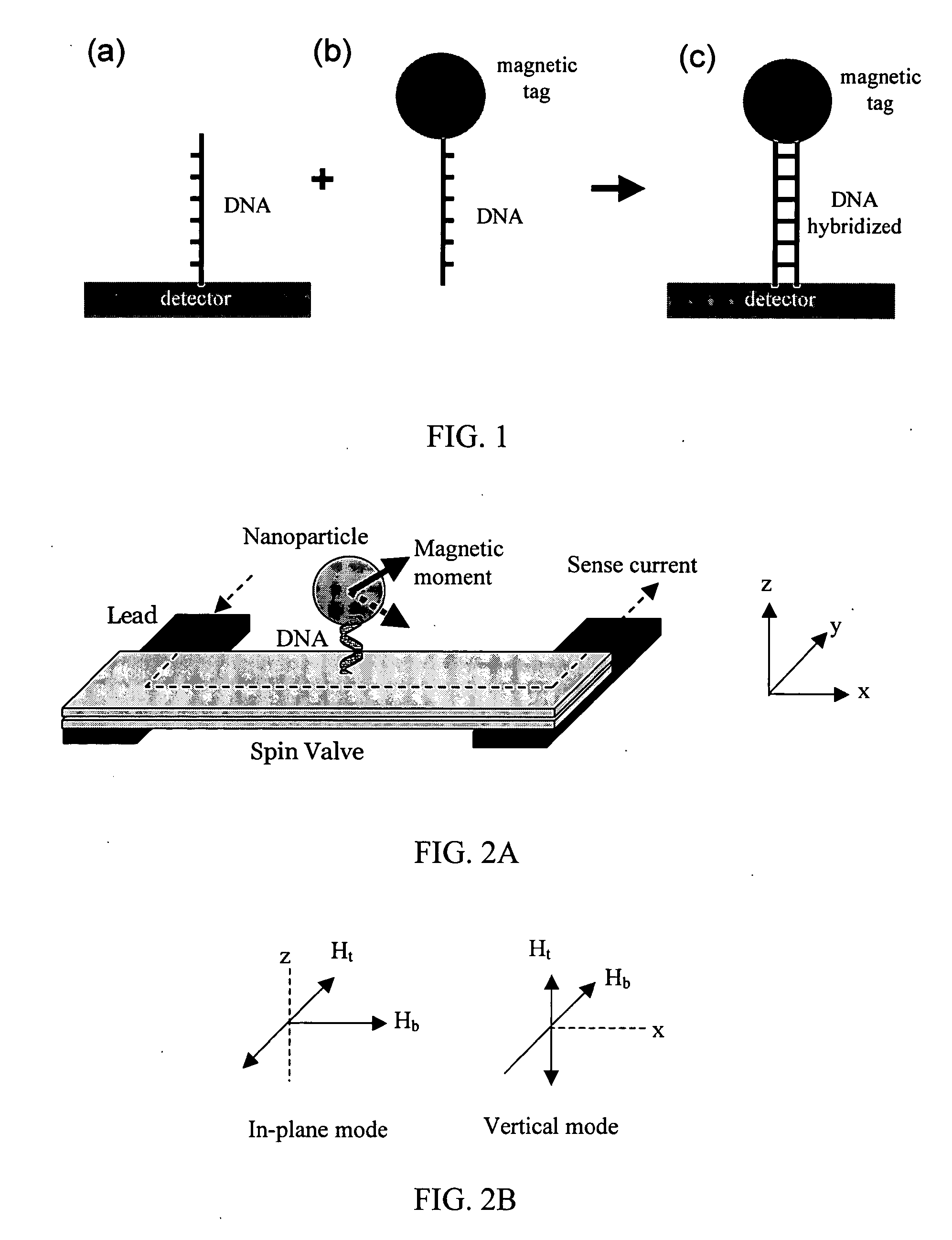Magnetic nanoparticles, magnetic detector arrays, and methods for thier use in detecting biological molecules
a technology of magnetic detectors and nanoparticles, applied in the direction of magnetic materials, thin magnetic films, digital storage, etc., can solve the problems of low sensitivity of microarray systems utilizing fluorescent labeling (tagging), and no system is commercially available to meet all of these requirements
- Summary
- Abstract
- Description
- Claims
- Application Information
AI Technical Summary
Benefits of technology
Problems solved by technology
Method used
Image
Examples
example 1
Detection of Magnetite Nanoparticles
[0081]A series of experiments was carried out to demonstrate that in addition to Co, Fe, and their alloys, ferrite such as magnetite and Mn-ferrite can also serve as biological tags, in accordance with the present invention. A monolayer of 16-nm Fe3O4 nanoparticles (NP) on 0.3-μm wide spin valve sensors was coated using polyethylenimine (PEI)-mediated self-assembly method (see, S. Sun, et al., J. Am. Chem. Soc., 124, 2884 (2002)), as shown in FIG. 3A. It was found that the voltage signal from a spin valve covered magnetite nanoparticles are nearly proportional to the bias voltage applied to the sensor as expected, shown in FIG. 3B, while the signal from a reference spin valve not covered with any magnetite nanoparticles is nearly zero. The voltage signals were measured from a Wheatstone bridge circuit by a lock-in amplifier at different bridge circuit biases. Furthermore, it is demonstrated that the measured signals could be well described by an a...
example 2
Spin Valve Sensors with Ultrathin Passivation
[0083]The reliability of a 4 nm passivation layer has been studied through a series of passive corrosion studies. A prototype MagArray™ chip was submerged into one of two DNA solutions that are currently used in standard DNA microarrays. The first solution, a hybridization buffer (pH=7.5), consists of a mixture of 0.6 M NaCl, 0.06 M C6H5Na3O7 (sodium citrate), and 0.1% SDS (sodium dodecyl sulfate). As its name indicates, this solution is the primary medium for the actual hybridization step in the microarray. The other solution, a blocking solution (pH=7.9), is a proprietary product from Surmodics (Eden Prairie, Minn.), primarily used to remove nonspecific binding sites in the test area. This process increases the likelihood of target molecules interacting with probes. The final addition to these solutions was the DNA (sonicated salmon sperm DNA) at a concentration of 0.1 mg / mL.
[0084]The performance of the spin valve sensor after DNA solut...
example 3
Synthetic Ferrimagnetic Nanoparticles
[0086]Here we disclose novel magnetic nanoparticle tags that are fabricated by physical methods instead of chemical routes and are suitable for labeling the target biomolecules to be detected in MagArray™. The tags consist of at least two thin ferromagnetic layers, preferably FexCo1-x, 0.5≦x≦0.7, or FexCo1-x based alloys. It is well known that FexCo1-x has the highest saturation magnetization (about 24.5 kGauss) among the known ferromagnetic materials (Bozorth, R. M., Ferromagnetism, D. Van Nostrand Company, 1951). These ferromagnetic layers are separated by nonmagnetic spacer layers such as Ru, Cr, Au, etc., or their alloys. The spacer layers are appropriately engineered to make the ferromagnetic layers coupled antiferromagnetically so that the net remnant magnetization of the resulting particles are zero or near zero, as shown in FIG. 5. A gold cap is added at the top of the antiferromagnetic stack so that the nanoparticle can be conjugated to ...
PUM
| Property | Measurement | Unit |
|---|---|---|
| thickness | aaaaa | aaaaa |
| diameter | aaaaa | aaaaa |
| width | aaaaa | aaaaa |
Abstract
Description
Claims
Application Information
 Login to View More
Login to View More - R&D
- Intellectual Property
- Life Sciences
- Materials
- Tech Scout
- Unparalleled Data Quality
- Higher Quality Content
- 60% Fewer Hallucinations
Browse by: Latest US Patents, China's latest patents, Technical Efficacy Thesaurus, Application Domain, Technology Topic, Popular Technical Reports.
© 2025 PatSnap. All rights reserved.Legal|Privacy policy|Modern Slavery Act Transparency Statement|Sitemap|About US| Contact US: help@patsnap.com



